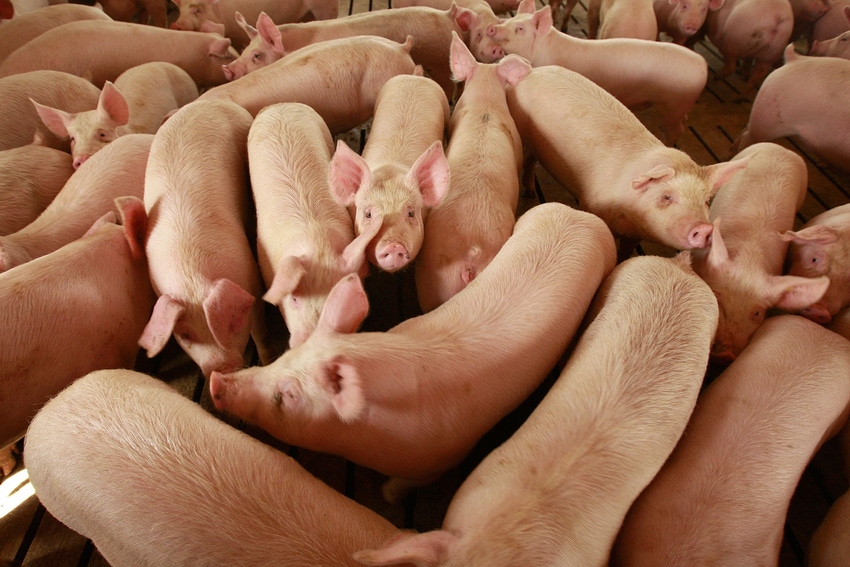Current feed prices already turning 2018 outlook into expectation for losses.
July 13, 2017

Pork producers have been watching the weather forecast almost as intently as crop producers because higher feed prices, driven by weather forecasts, have become a new threat to their returns, Purdue University livestock economist Chris Hurt said.
According to Hurt, current feed prices are already high enough to turn the 2018 outlook into expectations for losses.
In the U.S. Department of Agriculture’s June “Hogs & Pigs” report, pork producers reported that they continue to expand the breeding herd, with an increase of 1%. Hurt said with continued increases in the number of pigs per litter, pork production has been growing at about 2-3% per year.
“The market herd was reported to be up 3.6%, with pigs coming to market in the third quarter up 4% and those coming to market in the fourth quarter up 3%,” Hurt said.
For farrowings into the fall, producers told USDA that they would maintain at the same level. If this transpires, Hurt said the supply of pigs to be marketed in the winter and spring of 2018 will be around 1% higher.
As far as states to watch, Hurt said over the past two years, the most rapid breeding herd growth has been in Missouri, with 45,000 new animals, and Illinois, with 40,000 additional animals. Iowa has added 30,000 head.
“It is interesting to see that the recent growth is back in the heart of the traditional hog/corn belt. This is most likely being driven by new packing capacity, which is located in the traditional pork production areas,” he said.
Pork production has been up 2% in the first half of 2017, and hog prices have been 5% higher. Hurt said this is an unusual combination and is the result of strong pork export demand and lower retail prices in the domestic market that are helping spur consumption.
According to Hurt, pork exports have been having a good year. Pork exports through May were up 14%, led by increases to Mexico and South Korea. So far this year, the U.S has been exporting 23% of its domestic production.
Mexico has remained the number-one destination for exported pork since 2015, which Hurt said reminds the industry that opening North American Free Trade Agreement negotiations is especially important to U.S. agriculture and to the pork industry in particular.
“Because of strong pork exports, the 2% higher pork production has moved into the export market. This means that the amount of pork available for U.S. consumers is about the same as last year. Given that there are more people in the country, per capita supplies are actually down this year,” Hurt explained.
Packer and retail margins have been very high for pork this year, but Hurt said both are expected to be lower in the last half of the year due to more processing capacity. Retail pork prices in 2017 have been 2% lower, which Hurt explained is stimulating consumption and supporting hog prices, even with larger production.
“Looking forward, pork supplies are expected to be 4% higher in the third quarter and then drop to 3% higher in the last quarter of 2017,” Hurt said.
Pork production during the first half of 2018 is expected to be up 1-2%, but only if producers follow through with unchanged farrowing levels this summer and fall, he added.
Hurt suggested that prices will stay above year-ago levels in the last half of the year. Live-weight prices are expected to average in the high $50s in the third quarter and then drop to the high $40s for the final quarter of 2017. Live prices for the first half of 2017 are currently expected to average in the very low $50s.
Weather brings feed prices to forefront
Feed prices have suddenly become an important concern as drought conditions in the upper Great Plains are worsening, Hurt noted.
In fact, he said weather forecasts out to July 23 are for above normal temperatures and below normal precipitation for the central and northern Great Plains and all of the Corn Belt. “This suggests that the majority of the nation's corn crop will be pollinating under stressful weather conditions,” he warned.
December 2017 corn futures are currently at $4.12/bu., and December 2017 soybean meal futures are $345 per ton. At these levels, Hurt explained that costs of producing pork are distinctly higher.
“Over the past year, the estimated total costs of production have been near $50s per live hundredweight. With the current price levels, those costs rise to about $53 over the coming 12 months. Most of the increase comes from corn,” Hurt said.
In the past 12 months, the U.S. average corn price farmers received was $3.38/bu., and current futures markets are suggesting that could rise to $3.99 -- a 61-cent increase. Soybean meal prices at Decatur, Ill., averaged about $329 per ton over the past year, and current futures markets suggest around $343 per ton for the coming 12 months.
“Higher feed costs will cut pork producer margins,” Hurt said. “Returns are strong this quarter, with an estimated $18-per-head profit above all costs, but margin prospects turn negative in the final quarter this year, at $11 per head.”
Prospects for 2018 remain negative, with an estimated average loss of $10 per head.
“Losses in 2018 would be the result of lower hog prices in combination with higher feed prices. These are the good times for the pork industry, with strongly positive margins this summer. However, lower hog prices into the fall and winter, along with continued higher production into 2018, will lower hog prices,” Hurt said.
Anticipated harmful weather in the coming weeks means that whatever weather conditions do unfold will determine how high feed prices go, he added.
Even with the potential for higher prices, Hurt said ingredient buyers can take a bit of comfort in the large world inventories of feed ingredients, which will temper the upside in prices.
“Weather markets tend to peak around the period of harmful weather and then moderate as weather improves or as we move through the marketing year," Hurt explained. "This likely suggests more of a hand-to-mouth buying strategy for now and suggests caution in buying large amounts of feeding needs for the 12 months right now.”
If feed prices should continue to rise, Hurt said some breeding herd liquidation could transpire this fall, which would help increase hog prices for the last half of 2018. Still, he said “it is too early to predict this outcome right now. Watch the weather!”
You May Also Like
.png?width=300&auto=webp&quality=80&disable=upscale)
.png?width=300&auto=webp&quality=80&disable=upscale)

